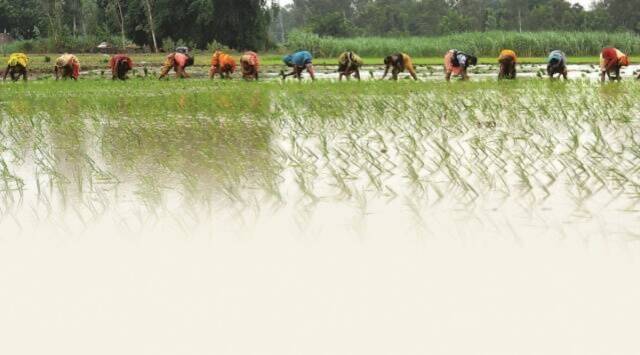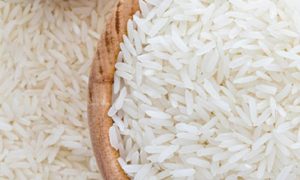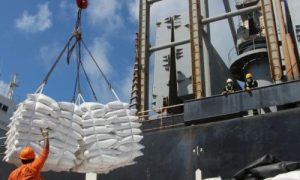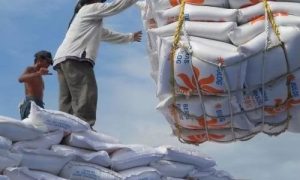With 85% paddy transplantation left, timely monsoon a blessing in disguise

According to the Punjab Agriculture Department, the state aims to cultivate approximately 31.68 lakh hectare of rice, including non-Basmati and Basmati varieties, this year.
With the southwest monsoon expected to cover the entire state in a day or so, Punjab may experience a lesser impact on its groundwater this season as 85 per cent area of water-intensive paddy crops is yet to be transplanted. The combination of transplantation and monsoon rains will help in conserving the state’s groundwater.
According to the Punjab Agriculture Department, the state aims to cultivate approximately 31.68 lakh hectare of rice, including non-Basmati and Basmati varieties, this year. Sowing has already taken place on around 5 lakh hectare, with 4.5 lakh hectare utilising the puddled method and around 41,000 hecatre using Direct Seeding Rice (DSR).
The paddy transplanting process in the state was divided into four phases, with the first commencing on June 10. The remaining phases began on June 16, June 19, and June 21 in different districts of the state. Punjab State Power Corporation Limited (PSPCL) was responsible for supplying eight hours of power to the districts from the notified dates of transplantation.
Experts have noted that the DSR period has already ended in the state, and all remaining transplanting will be conducted using the puddled method, which requires large quantities of water. The field where transplantation takes place needs to be tilled with standing water using tractor-drawn disc harrows. For the first three weeks after transplanting, the plants require almost daily irrigation to maintain water-logged conditions at a depth of 2-3 inch. Even for the following 5-6 weeks, the crop needs to be irrigated every second or third day.
“When the monsoons are about to cover the state, puddled transplanting alongside will certainly lead to significant water saving,” said Dr Amrik Singh, District Training Officer, Punjab Agriculture Department.
The puddled method prevents weed growth by depriving them of oxygen in a submerged state. The experts from Punjab Agriculture University (PAU) Ludhiana have been recommending the late sowing of paddy with the onset of monsoon since long and also urging to sow the short varieties of paddy to save the water.
Paddy and Basmati transplantation in Punjab typically last for 40 to 50 days, starting in June and concluding at July end. If the state receives sufficient rainfall during this period, the stress on groundwater would be reduced. Punjab is equipped with over 14 lakh electric tube wells that extract millions of liters of water per day during paddy transplantation and afterwards.
Experts suggest that if the soil becomes properly moistened with rainfall, it could lead to significant groundwater conservation when the state is expected 31.68 lakh hecatre under rice cultivation.
Punjab has been struggling to reduce the area dedicated to paddy cultivation, but it has not seen a decrease in recent years. Over the past five years, the area under rice cultivation has remained consistently high, with figures exceeding 31 lakh hectare.
In the 2022-23 season, the area covered by rice cultivation was 31.67 lakh hectare, including 4.94 lakh hectare of Basmati rice. Similarly, in 2021-22, the area was 31.45 lakh hectare, with 4.85 lakh hectare dedicated to Basmati rice. In 2020-21 season, the rice area was 31.49 lakh hectare, including 4.06 lakh hectare of Basmati rice. In 2019-20, the area was 31.42 lakh hectare, with 6.29 lakh hectare allocated for Basmati rice. Finally, in 2018-19, the area under rice cultivation reached 31.03 lakh hectare, including 5.11 lakh hectare of Basmati rice.
Meanwhile, the India Meteorological Department’s Chandigarh centre has reported that light to moderate rain and thundershowers are likely in many places in Punjab, Haryana, and Chandigarh from June 26 to June 28. A few places may experience rainfall on June 29 and June 30. Heavy rainfall, accompanied by thunderstorms and lightning, is expected in isolated areas of Punjab and Haryana during June 26-30, with very heavy rainfall predicted in the southern parts of Haryana on June 26. Thundershowers and gusty winds reaching speeds of 40-50 kmph are likely in isolated areas of Punjab, Haryana, and Chandigarh on June 26.
Over the decades, the increase in the area under rice cultivation has led to the depletion of the groundwater table in the state. According to the Central Ground Water Board (CGWB) report, Punjab has been extracting more water than is being replenished, resulting in an imbalance. The rate of water extraction in Punjab is 1.66 times higher than the rate of replenishment. Out of the 138 blocks in Punjab, 109 are already categorized as ‘dark’ or over-exploited zones, indicating that groundwater extraction exceeds 100 percent in these areas.
The CGWB report also mentions that during the first three decades of the Green Revolution, from 1966-67 to 1999-2000, 73 blocks (53 percent) of Punjab declined into the dark/overexploited zone. From 1999 to 2018, the number of dark/overexploited blocks increased from 73 to 109.
If we consider the paddy area, it has increased from 2.93 lakh hectares (LH) to 26.12 LH, which is almost a nine-fold increase in the first three decades of gree revolution from 1966-67 to 1999-2000. From 2000 to 2022, the rice area increased from 26.12 LH to 31.67 LH.
On average, it requires 4,000 liters of water to grow one kilogram of rice. Considering that the state is cultivating rice on over 31 lakh hectares and producing around 12 to 13 million tonnes of rice, a staggering 48,000 to 52,000 billion liters of water is required for this level of rice production. In such a situation, a good monsoon can play a crucial role in conserving groundwater.














